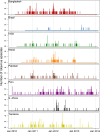Seasonality and within-subject clustering of rotavirus infections in an eight-site birth cohort study
- PMID: 29534766
- PMCID: PMC9134355
- DOI: 10.1017/S0950268818000304
Seasonality and within-subject clustering of rotavirus infections in an eight-site birth cohort study
Abstract
Improving understanding of the pathogen-specific seasonality of enteric infections is critical to informing policy on the timing of preventive measures and to forecast trends in the burden of diarrhoeal disease. Data obtained from active surveillance of cohorts can capture the underlying infection status as transmission occurs in the community. The purpose of this study was to characterise rotavirus seasonality in eight different locations while adjusting for age, calendar time and within-subject clustering of episodes by applying an adapted Serfling model approach to data from a multi-site cohort study. In the Bangladesh and Peru sites, within-subject clustering was high, with more than half of infants who experienced one rotavirus infection going on to experience a second and more than 20% experiencing a third. In the five sites that are in countries that had not introduced the rotavirus vaccine, the model predicted a primary peak in prevalence during the dry season and, in three of these, a secondary peak during the rainy season. The patterns predicted by this approach are broadly congruent with several emerging hypotheses about rotavirus transmission and are consistent for both symptomatic and asymptomatic rotavirus episodes. These findings have practical implications for programme design, but caution should be exercised in deriving inferences about the underlying pathways driving these trends, particularly when extending the approach to other pathogens.
Keywords: Cohort study; diarrhoea; pediatric infections; rotavirus; seasonality.
Conflict of interest statement
None.
Figures



References
-
- Neuzil KM and Kotloff KL (2015) Community-acquired diarrhoea in a world with rotavirus vaccine: a glimpse into the future. The Lancet Global Health 3, e510–e511. - PubMed
Publication types
MeSH terms
LinkOut - more resources
Full Text Sources
Other Literature Sources
Medical

